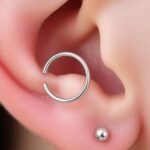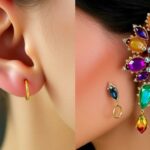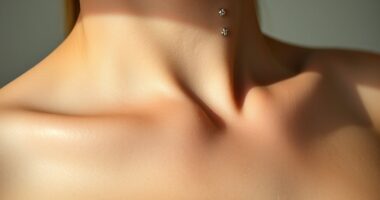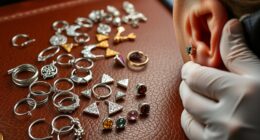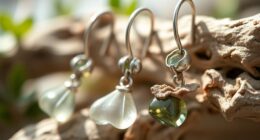Lip piercings are a vibrant form of self-expression, featuring styles like the classic labret and bold medusa. Each piercing has its unique charm, such as the Monroe, mimicking a beauty mark, or the edgy snake bites. Healing times vary, usually taking 6-8 weeks, so you'll want to prioritize aftercare. Jewelry choices are vast, from flat back studs to hoops, allowing for personalized flair. Exploring these piercings not only enhances your look but also connects to cultural significance. There's a lot more to uncover about the styles and their deeper meanings, so let's explore further!
Key Takeaways
- Lip piercings include various styles like labrets, medusas, and monroes, each offering unique aesthetics and cultural significance.
- Healing times vary; labret and snake bites typically heal in 6-8 weeks, while medusa and monroe piercings take 2-3 months.
- Proper aftercare is crucial to prevent infections; use saline solution and avoid touching the jewelry during the healing process.
- Jewelry options range from labret studs to hoops; materials like titanium and surgical steel minimize allergic reactions and ensure comfort.
- Lip piercings serve as forms of self-expression, reflecting personal identity, beauty ideals, and cultural significance throughout history.
Types of Lip Piercings

When it comes to lip piercings, there are several popular types you might consider, each offering a unique look and placement.
The labret piercing, one of the most common, is situated below the bottom lip and can be adorned with various jewelry options like studs or hoops. If you want something a bit more distinctive, a Medusa piercing sits in the center of the upper lip, just above the Cupid's bow, giving a bold aesthetic.
Another popular choice is the Monroe piercing, which mimics the beauty mark of Marilyn Monroe by placing it off-center on the upper lip.
For those who enjoy a dramatic flair, the Dahlia piercing involves two piercings at the corners of the mouth, often done in pairs. If you prefer something a bit more edgy, consider snake bites, which consist of two piercings on one side of the lower lip.
No matter which style you choose, each lip piercing not only enhances your look but also serves as a form of self-expression, reflecting your unique personality and style preferences.
Healing and Aftercare

Proper healing and aftercare are imperative for guaranteeing a successful lip piercing experience. Healing times for different types of lip piercings can vary; for instance, labret, dolphin bites, and snake bites typically heal in about 6 to 8 weeks, while Monroe and Medusa piercings may take 2 to 3 months.
To promote ideal healing, clean your piercing with a saline solution twice daily and use an alcohol-free mouthwash to maintain oral hygiene. Staying hydrated is essential during this period, as it helps reduce discomfort and supports the healing process.
Pay attention to your body and watch for signs of infection, such as increased redness, pus, or heightened pain. If you notice any of these symptoms, seek immediate attention from a professional.
It's also critical to avoid touching or twisting the jewelry while it heals, as this can cause irritation and complications. By following these aftercare guidelines, you'll help guarantee that your lip piercing heals smoothly and looks great for years to come.
Jewelry Options

When it comes to lip piercings, you have a variety of jewelry options to take into account, from labret studs to hoops.
Think about the materials too—surgical steel, titanium, and gold all offer different benefits for comfort and style.
Don't forget to keep your jewelry clean and well-maintained to guarantee a healthy healing process.
Types of Jewelry Available
Lip piercings offer a variety of jewelry options that cater to personal style and comfort. For labret piercings, you can choose from flat back studs, hoops, and circular barbells, giving you flexibility in how you express yourself.
Flat back studs are particularly popular for Monroe and Madonna piercings since they minimize irritation and promote healing, making your experience much more enjoyable.
If you're considering Medusa jewelry, flat back lip studs are your best bet. They fit snugly above the upper lip while ensuring comfort, which is essential for this unique placement.
For those with Dahlia piercings, flat back studs are also ideal, often featuring beautiful gemstone ends that enhance the aesthetic appeal.
Cheek piercings primarily use labret studs, where you can personalize your look with simple beads, diamonds, or even charms.
The wide range of options available means that you can find piercing jewelry that not only fits well but also reflects your style. Whether you prefer something understated or eye-catching, there's definitely a type of jewelry available to suit your lip piercings.
Material Considerations for Jewelry
Choosing the right material for your lip piercing jewelry plays a significant role in your comfort and safety. Popular options include titanium, surgical steel, and gold. Titanium is highly recommended due to its biocompatibility and low allergy risk, making it a safe choice for initial piercings, which typically use 14G (1.6mm) jewelry.
When selecting your jewelry, consider the design. Flat back studs are particularly favored for Medusa and Monroe piercings, as they help minimize irritation to your gums and teeth while providing a secure fit. You can also customize your jewelry by selecting various styles, lengths (usually between 5mm to 8mm), and even gemstones, allowing you to express your personal style.
Always prioritize high-quality materials to avoid allergic reactions and guarantee a smooth healing process. While gold can be a beautiful option, make sure it's of a high karat to reduce the risk of irritation.
Jewelry Maintenance Tips
To keep your lip piercing jewelry in top shape, regular maintenance is key. Start by cleaning your jewelry frequently with a saline solution to prevent buildup and maintain hygiene. This simple step helps you avoid infections and irritation.
Always opt for high-quality materials like surgical steel, titanium, or a Gold Flat Back. These choices minimize the risk of allergic reactions, ensuring your comfort during wear. You should inspect your jewelry regularly for any signs of wear or damage. If you notice any degradation, replace the piece immediately to avoid complications.
When it comes to changing your jewelry, patience is essential. Wait until your piercing is fully healed, which typically takes 6-8 weeks for most labret piercings. This waiting period helps you minimize the risk of infection or irritation during the shift.
For added comfort, consider using flat back studs or low-set prong earrings. These designs reduce irritation against your gums and teeth, making your experience more enjoyable.
Unique and Double Piercings

When you're considering unique and double piercings, pairing them can create a striking aesthetic balance.
Options like Snake Bites and Dahlia piercings emphasize symmetry while showcasing your personal style.
Plus, with various variants like Angel Bites and Dolphin Bites, there's plenty to choose from to express your individuality.
Pairing for Aesthetic Balance
Pairing unique and double piercings can create a striking aesthetic balance that enhances your facial features. For instance, you might consider Snake Bites, which feature two side labret piercings on your lower lip. This setup not only draws attention but also maintains symmetry that flatters your face.
If you prefer something on the upper lip, Angel Bites offer a similar symmetrical appeal, showcasing beauty through balance.
Alternatively, the Dolphin Bite piercing, with two labrets centered on your lower lip, gives a distinctive look while still keeping that harmony.
If you're feeling bold, Shark Bites provide an edgy vibe with two spider bites on either side of the mouth, making a strong statement.
If you want to push the envelope, Canine Bites involve a total of four piercings—two on the upper lip and two on the lower lip. This intricate design can truly elevate your aesthetic game, creating a mesmerizing look that's sure to turn heads.
Variants of Double Piercings
Exploring the world of double piercings reveals a variety of enchanting options that can elevate your style. Among the popular choices are Dahlia piercings, which are done in pairs at the corners of your mouth. They typically heal within 6 to 8 weeks, using flat back studs for comfort.
If you prefer a fierce look, consider Snake Bite piercings—two symmetrical labret piercings on your lower lip that resemble fangs, also healing within that same timeframe.
For an eye-catching effect, Angel Bites are a fantastic option. These piercings are placed on your upper lip and can create a striking appearance, with healing times varying based on your body's response.
Another bold choice is Shark Bite piercings, which feature two spider bites on either side of your lower lip, offering a daring aesthetic that generally heals in about 6 to 8 weeks.
If you're looking for versatility, Dolphin Bite piercings focus on a central labret stud on your lower lip, giving you the chance to combine them with other piercings.
Each option brings its unique flair, allowing you to express yourself creatively.
Fun Facts and Cultural Significance

Lip piercings, with their rich history and cultural significance, have fascinated people across generations. They trace back to various indigenous cultures, where they often symbolized spiritual beliefs, rites of passage, or status within the community. The labret, a classic lip piercing style, has been a prominent choice for centuries, showcasing its deep-rooted importance.
In contemporary culture, the Medusa piercing has emerged as a bold statement, gaining popularity among alternative fashion enthusiasts since the early 2000s. Inspired by iconic figures like Marilyn Monroe, styles like the Monroe and Madonna piercings reflect evolving beauty standards and the quest for individuality. Each piercing can serve as a unique beauty mark, enhancing facial features and symmetry.
Lip piercings are powerful forms of self-expression, influenced by celebrity culture and social media, which showcase diverse jewelry styles and personal stories. They not only act as fashion statements but also symbolize rebellion against conventional norms.
With their aesthetic appeal and cultural depth, lip piercings continue to resonate, allowing wearers to express their identity boldly and uniquely.
Choosing the Right Piercing

When it comes to expressing your individuality through piercings, choosing the right one can make all the difference.
Start by considering your facial anatomy and personal style; different lip piercings can enhance or detract from your overall appearance. Consult with a professional piercer to explore options like labret, Monroe, or Medusa piercings. Each has unique healing times and jewelry requirements that you'll want to understand before making a decision.
Evaluate your lifestyle as well. If you're active in sports or have a busy routine, some piercings might be prone to irritation or injury, impacting your daily life.
Research the cultural significance and aesthetic appeal of various lip piercings to find a style that truly resonates with your personal expression and identity.
Risks Associated With Lip Piercings

Despite their popularity, lip piercings come with several risks that you should consider before taking the plunge. Understanding these risks will help you make an informed decision about whether a lip piercing is right for you.
Here are some potential complications to keep in mind:
- Infection: If you neglect proper aftercare, you might experience symptoms like redness, swelling, and pus discharge.
- Allergic reactions: Some individuals may develop irritation and discomfort from certain metals, particularly nickel.
- Keloids: If you're prone to them, raised scars can form, complicating the healing process and requiring medical intervention.
- Gum recession: Larger jewelry can damage your teeth and gums, leading to enamel erosion and gum recession over time.
Additionally, be aware of jewelry migration or rejection, which can occur if the piercing isn't sufficiently cared for. Your body might push the jewelry out, making it essential to follow aftercare guidelines closely.
Maintenance of Lip Piercing Jewelry

Proper maintenance of your lip piercing jewelry is crucial for guaranteeing hygiene and promoting healing. Regular cleaning is important to prevent buildup that can lead to infections. Use saline solutions or alcohol-free mouthwash to clean the interior of your jewelry.
Make it a habit to inspect your jewelry frequently for any signs of wear or damage, as this can affect the healing process and overall health of your piercing.
Avoid changing your jewelry too soon; it's recommended to wait until your piercing is fully healed, typically around 6-8 weeks. Changing it prematurely can lead to irritation or infection.
When you do decide to change your jewelry, verify all materials are sanitized and suitable for sensitive piercings. Surgical steel or titanium is preferred for their biocompatibility.
Lastly, keep an eye out for any signs of irritation or allergic reactions. If you notice symptoms like swelling, redness, or pain, consult with a professional piercer promptly.
Taking these maintenance steps not only helps in the healing process but also guarantees that you enjoy your lip piercing without complications.
Cultural and Personal Significance

Throughout history, lip piercings have held deep cultural and personal significance across various societies. From labrets to Medusa piercings, these adornments often symbolize rites of passage, spiritual beliefs, or personal identity.
In today's world, you might find that lip piercings serve as a powerful form of self-expression, enabling you to showcase your unique style and aesthetic preferences.
Here are some ways lip piercings reflect cultural and personal significance:
- Rites of Passage: In some cultures, getting a lip piercing marks a significant life milestone.
- Symbols of Rebellion: For many, these piercings are a bold statement against conventional beauty ideals.
- Fashion Statements: Influenced by social media and celebrities, lip piercings are now trendy accessories.
- Beauty Ideals: Styles like the Monroe and Madonna piercings highlight femininity and personal allure.
Ultimately, the cultural significance of lip piercings varies widely, allowing you to embrace them in a way that resonates with your personal identity.
Whether you view them as a fashion statement or a deeper symbol, their impact on self-expression is undeniable.
Frequently Asked Questions
Is My Lip Piercing Nesting or Embedding?
To determine if your piercing's nesting or embedding, check for irritation and how the jewelry sits. If it's flush with your skin or painful, you might be experiencing embedding; consult a professional if unsure.
How Painful Is a Philtrum Piercing?
A philtrum piercing typically registers a pain level between 3 to 5 out of 10. You'll feel a quick pinch, with some initial swelling and tenderness, but discomfort usually diminishes within a few days.
When Can I Change My Lip Piercing to a Smaller Bar?
You should wait 6 to 8 weeks for most lip piercings before changing to a smaller bar. Always guarantee swelling has subsided and consult a professional piercer to confirm your piercing's healing progress.
Can I Use a Labret for My Medusa Piercing?
"Don't put all your eggs in one basket." While you can use a labret for your Medusa piercing, it's best to opt for proper Medusa studs to guarantee comfort and ideal healing. Consult a professional piercer.
Conclusion
In the world of self-expression, lip piercings shine like diamonds, adding a unique touch to your style. Whether you choose a labret, medusa, or a daring double piercing, each option tells your story. Remember, healing takes patience, and the right jewelry can elevate your look. Embrace the cultural significance and personal meaning behind your choice, and don't forget the importance of aftercare. With the right mindset, your piercing journey can be as vibrant as you are!
Hi, my name is Danielle, and I’m an author for piercings-body.com. I have a passion for writing and love to share my knowledge on all things body piercing-related. I’m also a huge advocate for safe body modification practices and believe everyone should be able to make informed decisions about their bodies. When I’m not writing or blogging, I enjoy spending time with my family and friends, practicing yoga, and exploring new places.







